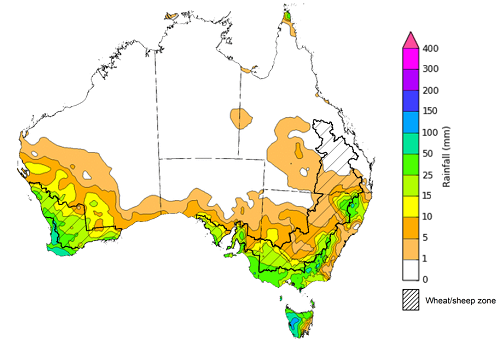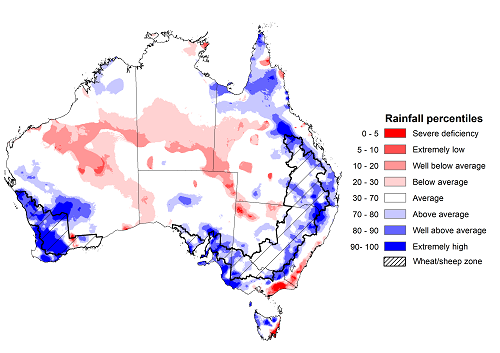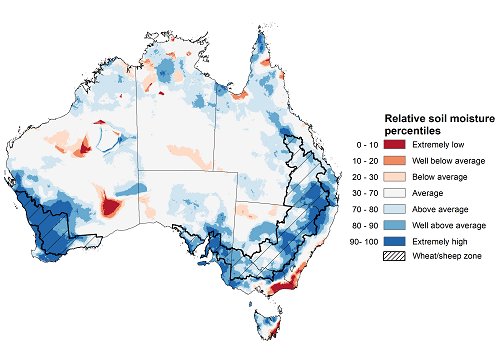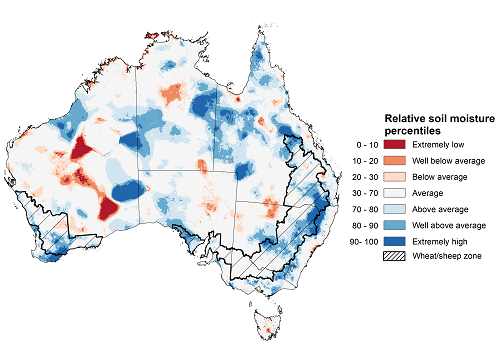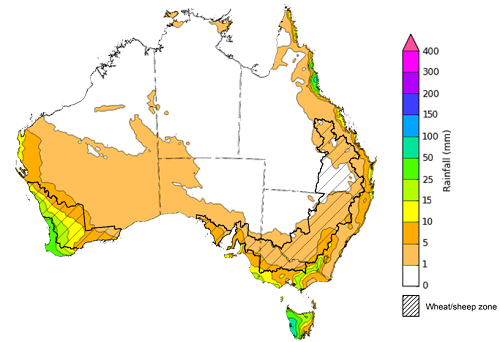Key issues
- During the week ending 4 August 2021, low pressure systems and associated cold fronts brought rainfall to parts of southern and eastern Australia. However, high pressure systems restricted rainfall across northern and central Australia during the week.
- Stored soil moisture across most growing regions will have supported ongoing plant development and yield potentials despite some eastern cropping regions receiving little to no rainfall. The continued wet conditions across parts of northern New South Wales and the south-west of Western Australia may require growers to switch to aerial spreading of urea and spraying of crops, which will lead to an increased cost of production. These conditions also raise the risk of the occurrence and spread of fungal diseases.
- Rainfall during July 2021 was average to well above average across much of New South Wales, Queensland, Victoria, South Australia, southern and northern Western Australia and Tasmania. Rainfall was below average to well below average during July 2021 for large areas of central Australia and south-east coastal regions of New South Wales, Victoria and Tasmania.
- Rainfall across eastern Australia (including South Australia) continues to support the growth of winter crops and pastures and build soil moisture levels. In Western Australia, well above average rainfall has benefited crop development following below average rainfall in June across most cropping regions. However, extremely high rainfall across the Great Southern region has not allowed for any alleviation from waterlogging and the associated water-damage to crops.
- The influence of high pressure systems is likely to bring clear conditions across much of Australia over the next 8 days. Rainfall is likely to be limited to the south-west of Western Australia, scattered areas of south-eastern Australia and the west coast of Tasmania during the 8 days to 12 August 2021.
- The dry conditions forecast for much of eastern Australia (including South Australia) will allow for some deep drainage and drying of saturated soil profiles in some areas, reducing the effects of waterlogging and associated water-damage. Crop development is expected to progress unimpeded with high levels of plant available moisture provided by previous heavy falls. The forecast rainfall for the south-west of Western Australia will add to already saturated soils, extending potential water-damage from waterlogging and preventing field access.
- Water storage in the Murray–Darling Basin (MDB) increased by 479 gigalitres (GL) between 28 July 2021 and 4 August 2021. The current volume of water held in storage is 19,222 GL, which represents 76% of total capacity. This is 58% or 7,058 GL more than at the same time last year.
- Allocation prices in the Victorian Murray below the Barmah Choke decreased from $129 per ML on 25 July 2021 to $125 per ML on 30 July 2021. Prices are lower in the Goulburn-Broken, Murrumbidgee, and regions above the Barmah choke due to the binding of the Goulburn intervalley trade limit, Murrumbidgee export limit, and Barmah choke trade constraint.
Climate
[expand all]
Rainfall this week
During the week ending 4 August 2021, low pressure systems and cold fronts brought rainfall to parts of southern and eastern Australia. In contrast, high pressure systems and clear skies limited rainfall across much of northern and central Australia.
Rainfall totals of between 10 and 50 millimetres were recorded across parts of eastern New South Wales, Victoria, southern South Australia, south-western Western Australia and much of Tasmania. Rainfall totals in excess of 50 millimetres were recorded in isolated parts of south-eastern New South Wales, south-western Western Australia and western Tasmania.
In cropping regions, rainfall totals of between 10 and 50 millimetres were recorded in parts of the far north-east and south-east of New South Wales, Victoria, western and central South Australia and much of Western Australia. Little to no rainfall was recorded across most remaining cropping regions in New South Wales, as well as much of Queensland.
Stored soil moisture across most growing regions will have supported ongoing plant development and yield potentials despite some eastern cropping regions receiving little to no rainfall. In some areas, such as northern New South Wales and the south-west of Western Australia, substantial rainfall totals pose a risk of continued waterlogging. The continued wet conditions may require growers to switch to aerial spreading of urea and spraying of crops, which will lead to an increased cost of production. These conditions also raise the risk of the occurrence and spread of fungal diseases.
Rainfall for the week ending 4 August 2021
©Commonwealth of Australia 2021, Australian Bureau of Meteorology - Issued: 04/08/2021
Note: The rainfall analyses and associated maps utilise data contained in the Bureau of Meteorology climate database, the Australian Data Archive for Meteorology (ADAM). The analyses are initially produced automatically from real-time data with limited quality control. They are intended to provide a general overview of rainfall across Australia as quickly as possible after the observations are received. For further information go to http://www.bom.gov.au/climate/rainfall/
Monthly rainfall
Rainfall during July 2021 was average to well above average across much of New South Wales, Queensland, Victoria, South Australia, southern and northern Western Australia and Tasmania. Rainfall was below average to well below average during July 2021 for large areas of central Australia and south-east coastal regions of New South Wales, Victoria and Tasmania. Little or no rainfall is typically recorded across much of northern and central Australia during July as it is the northern dry season.
The El Niño–Southern Oscillation (ENSO) remained neutral throughout July, having had little influence on Australia’s climate. Meanwhile, the Indian Ocean Dipole (IOD) was consistently negative, and the Southern Annular Mode (SAM) remained positive throughout July . A negative IOD is associated with more rainfall over eastern and southern Australia, and a positive SAM also typically results in more rainfall for parts of eastern and southern Australia but drier conditions in other parts of the south. Cold fronts and troughs generated above average rainfall across much of southern and eastern Australia during July . High pressure systems contributed to below average rainfall for much of central Australia.
July rainfall was average to well above average across cropping regions in New South Wales, Victoria, Queensland and South Australia. Near average rainfall fell across cropping regions in eastern Western Australia. Rainfall was well above average to extremely high for much of the remainder of Western Australia in July.
Rainfall across eastern Australia (including South Australia) continues to support the growth of winter crops and pastures and build soil moisture levels. However, well above average rainfall has resulted in isolated areas of waterlogging in parts of central and northern New South Wales. The parts of western Victoria and eastern South Australia that experienced very dry conditions during autumn have now likely received enough rainfall to support the establishment and growth of crops. In Western Australia, well above average rainfall has benefited crop development following below average rainfall in June across most cropping regions. However, extremely high rainfall across the Great Southern region has not allowed for any alleviation from waterlogging and the associated water-damage to crops.
Rainfall percentiles for July 2021
Note: Rainfall for July 2021 is compared with rainfall recorded for that period during the historical record (1900 to present). For further information, go to http://www.bom.gov.au/water/
Source: Bureau of Meteorology
Monthly soil moisture
Upper layer soil moisture in July 2021 was average to well above average for this time of year across much of Australia, reflecting rainfall patterns during the month. However, modelled upper layer soil moisture was extremely low to well below average across south-east coastal regions of New South Wales, Victoria and Tasmania. Upper layer soil moisture is important at the beginning of the winter cropping season since plant germination and establishment utilise this moisture.
Upper layer soil moisture was above average to well above average for this time of year across most cropping regions in New South Wales, Queensland, Victoria, South Australia and Western Australia. In regions that are showing extremely high soil moisture levels in both the upper and lower layers is indicative of a completely saturated soil profile, and in areas prone to waterlogging this is likely to result in moisture-damage to crop yield potential.
Modelled upper layer soil moisture for July 2021
Note: This map shows the levels of modelled upper layer soil moisture (0 to 10 centimetres) during July 2021. This map shows how modelled soil conditions during July 2021 compare with July conditions modelled over the reference period (1911 to 2016). Dark blue areas on the maps were much wetter in July 2021 than during the reference period. The dark red areas were much drier than during the reference period. The bulk of plant roots occur in the top 20 centimetres of the soil profile. Soil moisture in the upper layer of the soil profile is therefore useful indicator of the availability of water, particularly for germinating seed.
Source: Bureau of Meteorology (Australian Water Resources Assessment Landscape model)
Lower layer soil moisture for July 2021 was average to above average for this time of year across much of Australia, with well above average soil moisture in isolated parts of north-eastern, south-eastern and south-western Australia. Lower layer soil moisture was well below average to below average across parts northern and central Australia, and scattered parts of Western Australia.
In cropping regions, lower layer soil moisture was above average to well above average for parts of north-eastern and central New South Wales, south-eastern and northern Queensland, and the south of Western Australia and western regions in South Australia. Lower layer soil moisture was generally average in most remaining cropping regions.
Modelled lower layer soil moisture for July 2021
Note: This map shows the levels of modelled lower layer soil moisture (10 to 100 centimetres) during July 2021. This map shows how modelled soil conditions during July 2021 compare with July conditions modelled over the reference period (1911 to 2016). Dark blue areas on the maps were much wetter in July 2021 than during the reference period. The dark red areas were much drier than during the reference period. The bulk of plant roots occur in the top 20 centimetres of the soil profile. The lower layer soil moisture is a larger, deeper store that is slower to respond to rainfall and tends to reflect accumulated rainfall events over longer time periods.
Source: Bureau of Meteorology (Australian Water Resources Assessment Landscape model)
Rainfall forecast for the next eight days
The influence of high pressure systems is likely to bring clear conditions across much of Australia over the next eight days. Towards the end of the week, these high pressure systems are forecast to shift eastwards, allowing troughs and cold fronts to bring rainfall to the south-west of Western Australia, scattered areas of south-eastern Australia and the west coast of Tasmania.
Rainfall totals of between 10 and 50 millimetres are forecast for isolated parts of southern New South Wales and eastern Queensland, as well as parts of Victoria, the south-east of South Australia, south-west Western Australia and western Tasmania.
In Australia’s cropping regions, rainfall totals of between 10 and 50 millimetres are forecast for parts of the south-west of Western Australia. Little to no rainfall is forecast for most cropping regions in New South Wales, Victoria and South Australia and Queensland.
The dry conditions forecast for much of eastern Australia (including South Australia) will allow for some deep drainage and drying of saturated soil profiles in some areas, reducing the risk of waterlogging and associated water-damage. Crop development is expected to progress unimpeded with high levels of plant available moisture provided by previous heavy falls. If dry conditions continue, growers will be able to access fields for applications of urea and disease control programs in the coming weeks. The forecast rainfall for the south-west of Western Australia will add to already saturated soils, extending potential water-damage from waterlogging and preventing field access.
Total forecast rainfall (mm) for the period 5 August to 12 August 2021
©Commonwealth of Australia 2021, Australian Bureau of Meteorology - Issued: 04/08/2021
Water
Water storages, water markets and water allocations - current week
The Tableau dashboard may not meet accessibility requirements. For information about the contents of these dashboards contact ABARES.
Commodities
Information on weekly price changes in agricultural commodities is now available at the Weekly commodity price update.

